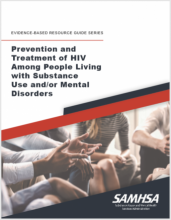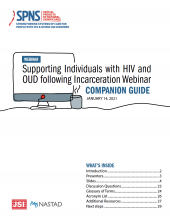
This document provides a quick overview of the federal discretionary funding programs that support essential aspects of the nation’s HIV response.



This document provides a quick overview of the federal discretionary funding programs that support essential aspects of the nation’s HIV response.
In recent years, the gap in the rate of opioid overdoses among Black and white Americans has narrowed significantly, with increases in Black mortality driven in part by the addition of synthetic opioids to other drugs.
Achieving the goals of the Ending the HIV Epidemic (EHE) Initiative depends on doing more to strengthen communities, reduce the harm associated with drug use, and prevent disease transmission.
Opioid agonist treatment (OAT) is the provision of medications (methadone and buprenorphine) that activate the opioid receptors to prevent withdrawal and reduce cravings for opioids.
This publication, part of SAMHSA's Evidence Based Resource Guide series, addresses the co-occurrence of HIV and mental illness and/or SUD.
This article describes how the HIV testing window period is a challenge related to prescribing PrEP for people who inject drugs, and discusses current approaches and how data are needed to help guide best practices.
This virtual session summary describes key takeaways from the August 2020 Let's Talk about SSPs as Essential Services conversation.
Developed as part of the Strengthening Systems of Care for People with HIV and Opioid Use Disorder project, this document contains brief descriptions of federal policy and systems changes due to coronavirus 2019 (COVID-19) that relate to the HIV and substance use systems of care, along w
This article includes a case report example from Boston Medical Center focused on prescribing buprenorphine via telehealth, an approach made possible by regulatory changes during the COVID-19 pandemic.
This document provides an overview of the SAMHSA State Opioid Response (SOR) Funding Opportunity Announcement (FOA) TI-20-012 for fiscal year (FY) 2020, with a specific focus on incorporating strategies to address HIV/infectious diseases, harm reduction, and stimulant use.